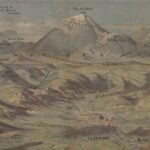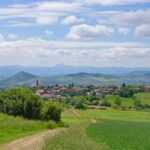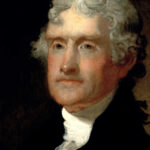What did nineteenth-century Americans think of Auvergne? In 1801, American ambassador William Short told President Thomas Jefferson that the Limagne — a sun-kissed expanse of meadowlands and pastures in Auvergne — was “certainly the most fertile the most highly cultivated & the most magnificent district that I have ever seen”.
Here’s an excerpt from Short’s letter:
I have just returned from Auvergne whither I informed you in my last of the 9th. of June I was going. We passed some time there near a considerable estate of a peculiar kind belonging to my friend—It consists entirely of mountain heights on which there is not a single house or a single tree, notwithstanding these heights extend for several leagues.—they are covered with snow one half of the year & at that time entirely uninhabited—these heights are rented out to different graziers & raisers of cattle, who send their stocks to pass the season—little huts of earth are erected there to lodge during that time, the persons who have charge of the cattle & make the cheese & butter which form a considerable part of the revenue.
It is in the mountains of this estate that one of the divisions takes place between the waters of the Loire & the Garonne—for as you know there are several separate divisions between their branches.—Here on one part of the estate there is a little source which takes its course east to go & join the Allier—& on another part of the estate, at about a leagues distance, a small lake whose issue takes its course west to go & join the Dordogne. I have had a great deal of pleasure in climbing up the mountains of Auvergne—there is a something in the mountain air congenial to my constitution which I have always experienced, from the first time of my approaching them in Albemarle—It is an epoch which no circumstance of time or place will ever erase from my mind.—I have seen in this voyage also the effects of the mountain air on others—my friend who is remarkably weak in general & two other of her female friends not much stronger, & accustomed only to the walks of level ground, climbed up without a great deal of fatigue to the top of the Puy de Dome—the latter part of the route for about an hour and three quarters is made on foot, being too steep to admit of the patache a kind of little one horse cart in which the first part of the road is passed.

The Puy de Dome, overhangs Clermont, & is celebrated on account the first experiment made by [Blaise] Pascal with the barometer.—It is a mountain perfectly insulated & in the form of a sugar loaf—Its form frequently recalled to my mind your Monticello—but on an immense scale, its summit being eight hundred & twenty toises, above the level of the ocean, & five hundred & sixty toises above the level of the lower part of Clermont which stands at its foot—the level space on the summit of this mountain is smaller than that of the top of Monticello & the sides of the mountain all around more steep—the horizon all around without limits—& the view such as I believe it is impossible to form an idea of.
Here is what the author of the Description of Auvergne, says of it & without exageration, ‘La magnificence & l’etendue du tableau qui se presente, (from this summit) vous ravit jusqu’a l’effroi; l’oeil intimidé semble hésiter, & n’ose d’abord parcourir un espace aussi vaste; on ne peut se defendre d’une emotion inconnue, mêlée de crainte & d’admiration; il faut quelque tems pour s’accoutumer à un spectacle si magnifique.’—One of the objects which enters into this picture is the plain of the Limagne, which extends in length to right & left several leagues out of view, & varying in its breadth, but bounded—filled with populous cities such as Riom, Clermont. &c. & cultivated like a garden–square, in its whole extent. The Limagne is & has been from time immemorial one of the most fertile & enchanting spots of the earth—Sidonius Apollinarius & Gregoire de Tours have both celebrated it, & the former among other encomiums, says, that strangers who have once seen the Limagne, forget their country & can no more be prevailed on to quit it.—I do not perceive that it had altogether that effect on me—but it is certainly the most fertile the most highly cultivated & the most magnificent district that I have ever seen—I know nothing that can be compared with it as to the magnificence of its views—& only that small part of Valencia, called the Huerta, as to cultivation & fertility.
In many ways, little has changed since Thomas Jefferson’s time. Auvergne is still known, not only for its rustic beauty but also for its ecological cleanliness. In fact, in 2023, Cantal — a department of Auvergne — was named France’s least-polluted region.
Want to know what other historical and literary figures thought of Auvergne? Click “History and Literature” below for more.








